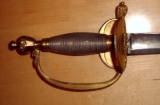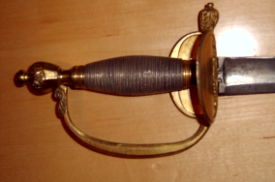
1796 Pattern British Infantry Officer's Sword
Encyclopedia
The 1796 Pattern British Infantry
Officers
Sword
was carried by officers of the line infantry
in the British Army
between 1796 and the time of its official replacement with the gothic hilted sword
in 1822.
This period encompassed the whole of the Napoleonic Wars
.
blade, i.e. one straight, flat backed and single edged with a single fuller on each side. The hilt gilt brass with a knucklebow, vestigial quillon and a twin-shell guard somewhat similar in appearance to that of the smallswords which had been common civilian wear until shortly before this period. The pommel was urn shaped and, in many later examples, the inner guard was hinged to allow the sword to sit against the body more comfortably and reduce wear to the officer's uniform. Blades were commonly quite extensively decorated, often blued and gilt.

"Nothing could be more useless or ridiculous than the old infantry regulation [sword]; it was good for neither cut nor thrust and was a perfect encumberance. In the Foot Artillery, when away from headquarters, we generally wore dirk
s instead of it" .
Infantry
Infantrymen are soldiers who are specifically trained for the role of fighting on foot to engage the enemy face to face and have historically borne the brunt of the casualties of combat in wars. As the oldest branch of combat arms, they are the backbone of armies...
Officers
Officer (armed forces)
An officer is a member of an armed force or uniformed service who holds a position of authority. Commissioned officers derive authority directly from a sovereign power and, as such, hold a commission charging them with the duties and responsibilities of a specific office or position...
Sword
Sword
A sword is a bladed weapon used primarily for cutting or thrusting. The precise definition of the term varies with the historical epoch or the geographical region under consideration...
was carried by officers of the line infantry
Line infantry
Line infantry is a type of infantry which composed the basis of European land armies from the middle of the 17th century to the middle of the 19th century....
in the British Army
British Army
The British Army is the land warfare branch of Her Majesty's Armed Forces in the United Kingdom. It came into being with the unification of the Kingdom of England and Scotland into the Kingdom of Great Britain in 1707. The new British Army incorporated Regiments that had already existed in England...
between 1796 and the time of its official replacement with the gothic hilted sword
Gothic Hilted British Infantry Swords (1822, 1827, 1845, 1854 and 1892 Patterns)
The gothic hilted swords were a family of swords carried by officers and some NCOs of the British Army between 1822 and the present day. They were primarily infantry swords, although they were also regulation pattern for some other officers such as surgeons and staff officers...
in 1822.
This period encompassed the whole of the Napoleonic Wars
Napoleonic Wars
The Napoleonic Wars were a series of wars declared against Napoleon's French Empire by opposing coalitions that ran from 1803 to 1815. As a continuation of the wars sparked by the French Revolution of 1789, they revolutionised European armies and played out on an unprecedented scale, mainly due to...
.
Design
The sword was introduced by General Order in 1796, replacing the previous 1786 Pattern. It was similar to its prececesor in having a spadroonSpadroon
The Spadroon is a light sword with a straight blade of the cut and thrust type. The style became popular among military and naval officers in the 1790s, spreading from England to the United States and to France, where it was known as the épée Anglaise. Hilts were often of the beaded or "five-ball"...
blade, i.e. one straight, flat backed and single edged with a single fuller on each side. The hilt gilt brass with a knucklebow, vestigial quillon and a twin-shell guard somewhat similar in appearance to that of the smallswords which had been common civilian wear until shortly before this period. The pommel was urn shaped and, in many later examples, the inner guard was hinged to allow the sword to sit against the body more comfortably and reduce wear to the officer's uniform. Blades were commonly quite extensively decorated, often blued and gilt.

Criticism
The 1796 Pattern Sword was not renowned as a great fighting sword. The blade was weak and the hilt gave very little protection to the hand.. General Cavalie Mercer of the Royal Artillery, who wore the same sword stated that:"Nothing could be more useless or ridiculous than the old infantry regulation [sword]; it was good for neither cut nor thrust and was a perfect encumberance. In the Foot Artillery, when away from headquarters, we generally wore dirk
Dirk
A dirk is a short thrusting dagger, sometimes a cut-down sword blade mounted on a dagger hilt rather than a knife blade. It was historically used as a personal weapon for officers engaged in naval hand-to-hand combat during the Age of Sail.-Etymology:...
s instead of it" .

